Cooking rice seems simple until you’ve scraped burnt grains from the pot or spooned out something closer to porridge than dinner. Too much water can leave it gummy, too little and it’s dry and hard. Maybe you’ve tried to fix it by guessing water ratios, only to end up with inconsistent results every time. I’ve been there too, and I remember thinking rice was just unpredictable.
This guide will change that. It’s the only one you’ll need to master perfect steamed rice with four foolproof methods. Whether you’re using the stovetop, a rice cooker, an Instant Pot, or even the microwave, you’ll learn exactly how to get fluffy, separate grains every time. You’ll also discover the simple science behind rice so you can fix problems before they happen.
We’ll walk through the core principles, compare each cooking method, share step-by-step instructions, and even troubleshoot with visuals. And because rice is rarely served alone, I’ll share some of my favorite pairings that turn a pot of rice into a complete meal.
Table of Contents
Table of Contents
The 3 Golden Rules of Perfect Rice (The Science Made Simple)
Making perfect steamed rice every time is not about luck, it’s about understanding three simple principles. These are the golden rules that apply no matter which method you use.
Rule 1: The Rinse
Rinsing rice removes excess surface starch that makes grains clump. Place your rice in a fine-mesh strainer or bowl, cover with cold water, swirl with your fingers, then drain. Repeat until the water is mostly clear. This also removes any dust from processing.
Rule 2: The Ratio
The water-to-rice ratio is the heart of fluffy rice. For most long-grain white rice, 1 cup rice to 1.5 cups water gives a tender yet distinct texture. Short-grain often needs 1:1.75, while jasmine and basmati can be perfect at 1:1.25 to 1.5. Once you know your rice type, you can fine-tune until you find your sweet spot.
Rule 3: The Rest
Resting rice after cooking transforms good rice into great rice. Once the heat is off, keep the lid on and let it sit for 10 minutes. This allows steam to redistribute evenly so the bottom grains are as fluffy as the top. Skipping this step can leave you with uneven texture and damp patches.
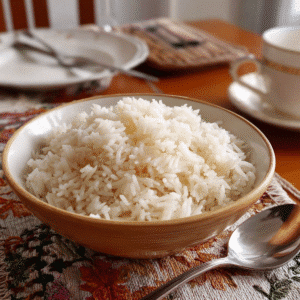
Perfect Steamed Rice
Ingredients
- 1 cup long-grain white rice
- 1.5 cups water
- Pinch of salt optional
Instructions
- 1. Rinse rice until water runs clear.
- 2. Add rice and water to cooking vessel of choice.
- 3. Cook using chosen method.
- 4. Let rest covered.
- 5. Fluff and serve.
Notes
Choosing Your Method: Pros and Cons
Before you start cooking, it helps to choose the method that fits your kitchen, schedule, and style. Each approach has strengths and a few limitations.
| Method | Ease | Speed | Consistency |
| Stovetop | Requires attention to heat | Medium | High with practice |
| Rice Cooker | Very easy | Medium | Always consistent |
| Instant Pot | Easy once learned | Fast | Very consistent |
| Microwave | Simple for small portions | Fastest | Can vary |
If you want total control over texture, the stovetop is your best friend. For hands-off convenience, a rice cooker is unbeatable. Short on time? The Instant Pot gives you speed without sacrificing quality. And if you’re cooking just one portion, the microwave will save the day.
Method 1: The Classic Stovetop (Our Core Recipe)
The stovetop method is the most traditional way to make perfect steamed rice. Once you’ve mastered it, you’ll know exactly how rice should look, feel, and taste.
Step 1: Rinse Your Rice
Measure your rice and place it in a fine-mesh strainer or bowl. Cover with cold water, swirl gently, then drain. Repeat until the water runs mostly clear. This prevents stickiness and helps achieve that fluffy, separate-grain texture.
Step 2: Add Water and Bring to a Boil
Use the correct ratio for your rice type, such as 1 cup long-grain white rice to 1.5 cups water. Pour both into a medium saucepan with a tight-fitting lid. Add a pinch of salt if you like. Place over medium-high heat and bring to a rolling boil.
Confidence Tip: If you’re tempted to add extra water “just in case,” resist. Adding too much will almost always lead to mushy rice. Trust the ratio.
Step 3: Cover and Simmer on Low
Once boiling, cover immediately and reduce the heat to the lowest setting. Let it simmer gently without lifting the lid for 15 minutes for white rice.
Confidence Tip: Even one peek can release steam and throw off the cooking time, so keep the lid closed.
Step 4: Rest Off the Heat
Turn off the heat and leave the pot covered for 10 minutes. This step lets moisture settle evenly from top to bottom.
Step 5: Fluff with a Fork
Remove the lid and fluff gently with a fork, separating the grains without mashing them. Serve immediately or keep covered until ready to plate.
This method works beautifully with saucy mains. I often make it alongside our Quick & Easy Homemade Butter Chicken so the rich sauce has the perfect fluffy base.
Method 2: The Effortless Rice Cooker
If you want consistent results with zero guesswork, the rice cooker is your go-to. Once you set it, it does the job while you focus on the rest of the meal.
Step 1: Rinse Your Rice
Place the rice directly in the cooker’s inner pot. Rinse under cold water until it runs mostly clear, then drain well.
Step 2: Add Water
Use the ratio that matches your rice type, such as 1 cup long-grain white rice to 1.5 cups water. Many rice cookers have built-in measuring lines you can follow.
Confidence Tip: If you’ve struggled with uneven cooking before, make sure the pot is on a flat, level surface so water covers the rice evenly.
Step 3: Press Start and Wait
Close the lid, select the appropriate setting (usually “White Rice”), and press start. The cooker will switch to “Warm” automatically when done.
Step 4: Rest and Fluff
Leave the lid closed for 5–10 minutes after it switches to warm, then fluff with the paddle or a fork.
This hands-off method is a lifesaver when you’re making something more involved on the stove. I almost always use the rice cooker when our Quick & Easy Homemade Butter Chicken is simmering away.
Method 3: The Speedy Instant Pot / Pressure Cooker
When time is short, the Instant Pot makes perfect steamed rice in a fraction of the time without sacrificing texture.
Step 1: Rinse Your Rice
Rinse under cold water until it runs mostly clear. This helps prevent excess stickiness.
Step 2: Add Water and Seasoning
Place rinsed rice in the Instant Pot with a 1:1 rice-to-water ratio for most white rice varieties.
Confidence Tip: If you’re used to stovetop cooking, this may seem like too little water, but the Instant Pot traps steam so none escapes.
Step 3: Set to High Pressure
Close the lid, set the valve to “Sealing,” and cook on High Pressure for 3 minutes.
Step 4: Natural Release
Allow a 10-minute natural release before venting any remaining steam.
Step 5: Fluff and Serve
Fluff with a fork and serve right away, or keep on “Warm” until plating.
The Instant Pot method is perfect for when I’m prepping quick sides like Healthy Weeknight Meals with Tofu because the rice is done before the tofu finishes crisping in the pan.
Method 4: The Quick Microwave Method
When you only need a small portion or want rice in under 20 minutes, the microwave method delivers. While it’s not for large batches, it’s great for quick lunches or solo dinners.
Step 1: Rinse Your Rice
Measure ½ cup rice into a microwave-safe bowl and rinse until the water runs mostly clear. Drain well.
Step 2: Add Water
Add ¾ cup water for long-grain white rice. Adjust slightly for other types. A pinch of salt is optional.
Confidence Tip: Don’t be tempted to add extra water “just in case.” Too much water in the microwave leads to mushy grains.
Step 3: Cover and Cook
Cover the bowl with a microwave-safe lid or plate. Microwave on high for 10 minutes, then reduce power to 50 percent and cook for another 5 minutes.
Confidence Tip: If the rice looks slightly wet when you uncover it, that’s fine. The resting period will finish steaming.
Step 4: Rest and Fluff
Let it sit, covered, for 5 minutes. Fluff gently with a fork and enjoy.
I use this method when I’m making something simple like One-Pot Egg Dinners and don’t want to dirty more pans.
The Ultimate Visual Troubleshooting Guide
Even with the best method, rice can go wrong. Seeing the problem makes it easier to fix next time. In the article, this section will feature three clear labeled photos generated from our MidJourney prompts to show each issue and its solution.
Problem 1: Gummy & Mushy Rice
Cause: Too much water or not rinsing enough.
Solution: Reduce water slightly and rinse thoroughly until the water runs clear.
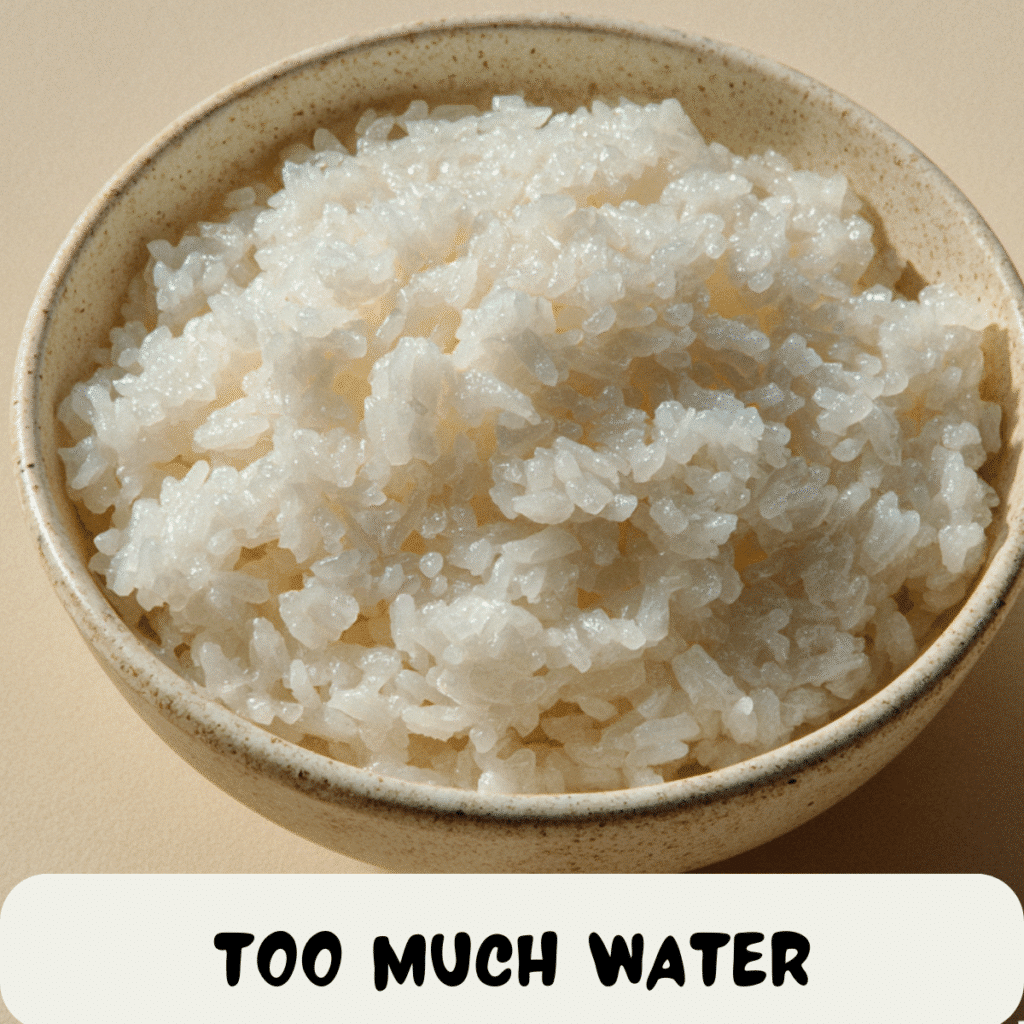
Problem 2: Burnt Bottom & Undercooked Top
Cause: Heat too high during simmering.
Solution: Use the lowest heat possible and don’t lift the lid until it’s done.
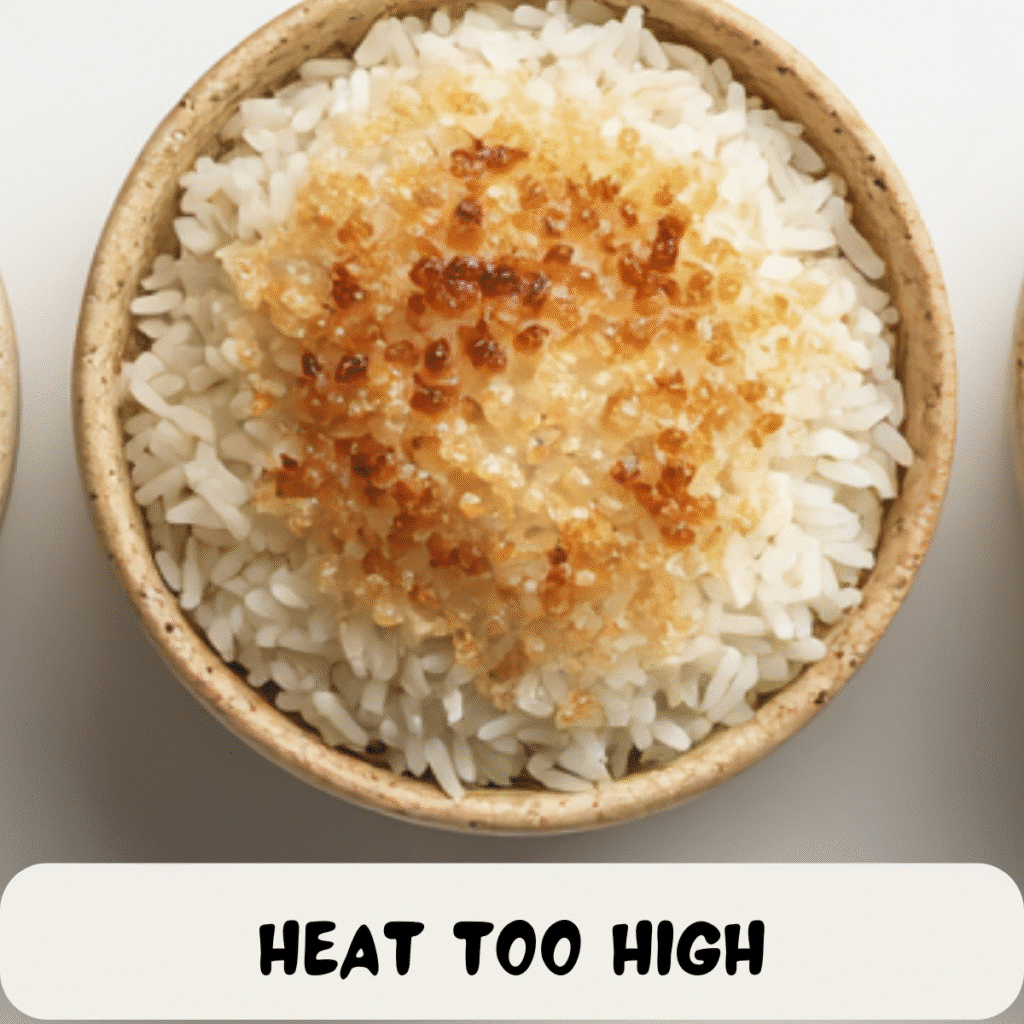
Problem 3: Dry & Hard Rice
Cause: Not enough water or a loose-fitting lid letting steam escape.
Solution: Check the lid seal and add 2–3 extra tablespoons of water next time.
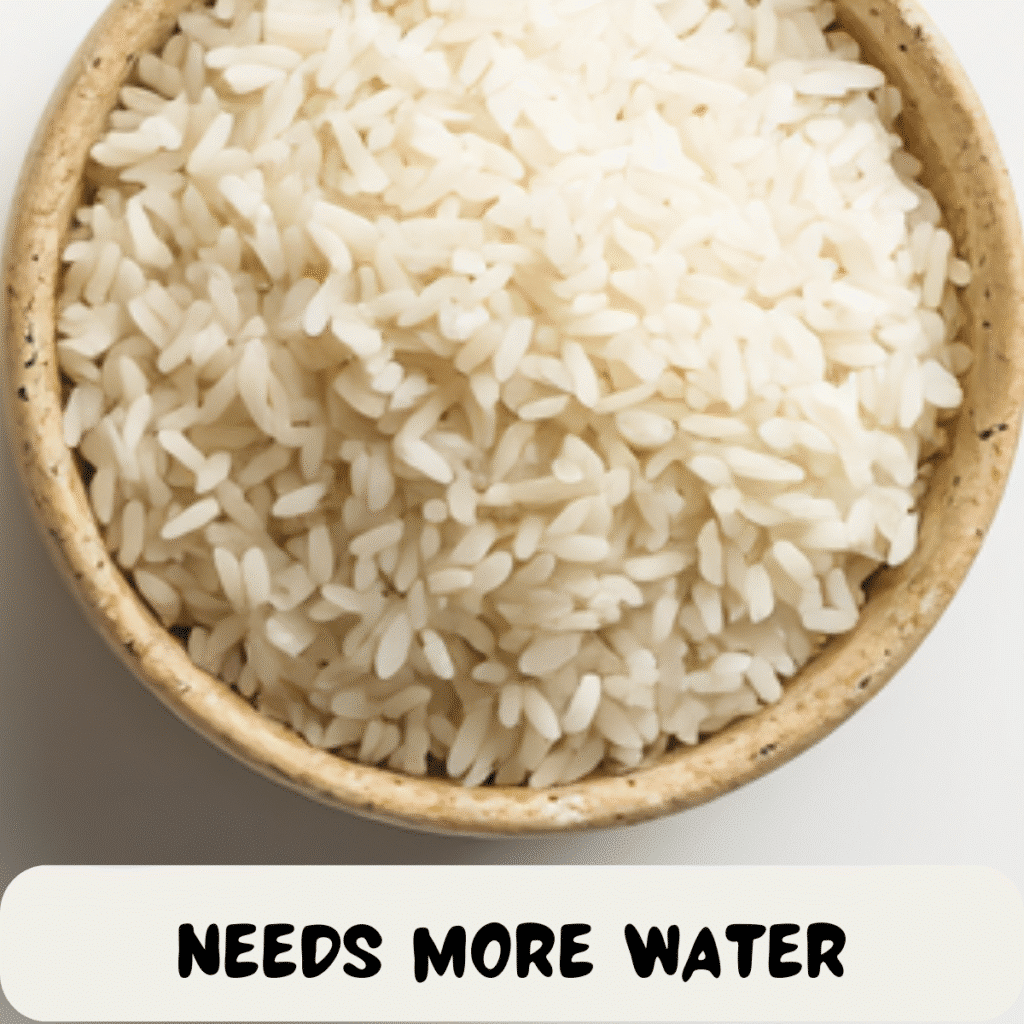
Learning to spot these textures instantly makes you a better rice cook and helps avoid repeat mistakes. I’ve saved more than one dinner by catching a potential flop early, especially when serving with sides like Ultimate Roasted Chickpeas where texture matters just as much as flavor.
Rice Variations and Water Ratios (Cheat Sheet)
Different rice types need different amounts of water to reach their best texture. This quick reference will help you get it right the first time.
| Rice Type | Best For | Stovetop Water Ratio (cups water per cup rice) |
| Long-Grain White | Everyday meals, pilafs | 1.5 |
| Basmati | Indian and Middle Eastern dishes | 1.25–1.5 |
| Jasmine | Southeast Asian dishes | 1.25–1.5 |
| Short-Grain White | Sushi, Korean and Japanese meals | 1.75 |
| Brown Rice | Healthy bowls, hearty sides | 2–2.25 |
Pro Tip: For Instant Pot cooking, reduce the water ratio by about 0.25 cups since steam is fully trapped. Rice cookers often have water line guides, check your model for accuracy.
Frequently Asked Questions
How do you cook perfect steamed rice?
Follow the golden trio: rinse well, measure your ratio precisely, and rest the rice after cooking. These principles work in any method, from stovetop to microwave.
What’s the secret to making perfect rice?
Consistency is key, always use the same measuring cup for rice and water, avoid lifting the lid during cooking, and give it time to rest.
How to steam the best rice?
Keep the heat low after boiling, use a tight-fitting lid, and resist the urge to peek. The steam is what finishes the cooking.
What is the 5 5 5 rule for cooking rice?
In the Instant Pot, that means 5 minutes on high pressure, 5 minutes natural release, and 5 minutes resting. It works well for softer rice, but I prefer 3 minutes high, 10 minutes natural release for fluffier grains.
Can I use chicken broth or other liquids instead of water?
Yes. Broth adds flavor, but be mindful of salt levels. reduce added salt if your broth is seasoned.
Why is my rice sticking to the bottom of the pot?
Usually the heat is too high or there isn’t enough water. Lower the heat to the minimum once boiling, and check your ratio.
What’s the best pot to use for cooking rice on the stove?
A heavy-bottomed pot with a tight lid works best. It prevents hot spots that cause burning and holds steam evenly.
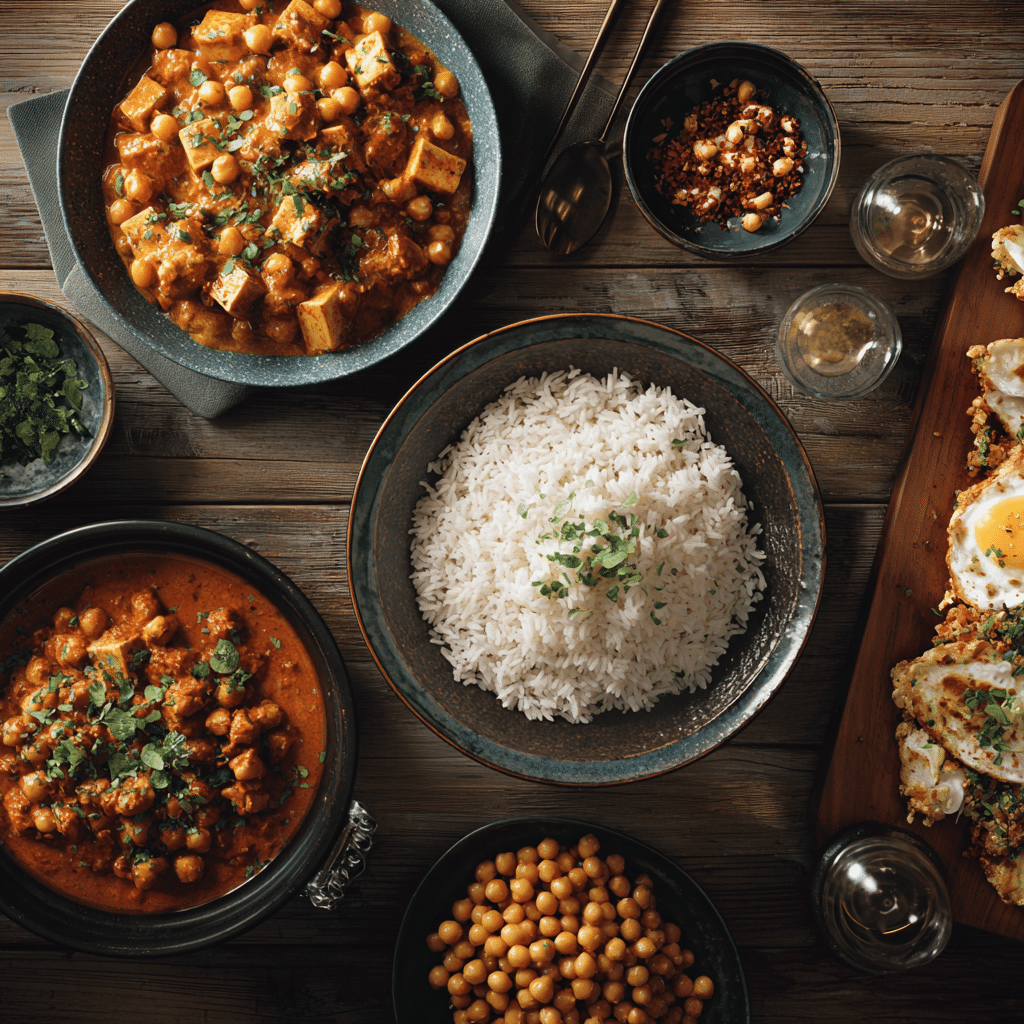
Conclusion
Mastering perfect steamed rice isn’t about luck. it’s about rinsing to remove excess starch, using the right water ratio, and letting the rice rest so steam finishes the job. Once you understand these three principles, any cooking method becomes a reliable tool in your kitchen.
Whether you’re making it on the stovetop, setting a rice cooker, firing up the Instant Pot, or using the microwave in a pinch, you now have the steps, tips, and troubleshooting skills to make flawless rice every time. The cheat sheet keeps your ratios clear, and the visual guide helps you correct problems before they become dinner disasters.
When it’s ready, pair your fluffy rice with rich mains like Quick & Easy Homemade Butter Chicken or lighter options like Healthy Weeknight Meals with Tofu. Keep it simple with One-Pot Egg Dinners or enjoy a crunchy contrast from Ultimate Roasted Chickpeas.
The next time you make rice, follow these steps and you’ll never have to settle for gummy, burnt, or uneven grains again.
If you tried this recipe, let us know how it turned out in the comments below! Don’t forget to follow me on Facebook and Pinterest for more delicious recipes.





